Table of contents
Quinoa ( Chenopodium quinoa ) is a versatile gluten-free pseudocereal when peeled and cooked . Quinoa grains, especially in organic quality, enrich vegetarian or vegan cuisine.
Use in the kitchen
How do I prepare quinoa? You can use cooked quinoa in a similar way to couscous or rice. To do this, you cook the mustard seed-sized, raw and peeled quinoa seeds whole and serve them as a tasty side dish or as a main course.
The cooked grains are ideal for preparing summer salads with ingredients such as cucumbers , spring onions and tomatoes ; the tri-coloured version ('Quinoa Tricolore') looks particularly appealing. Fresh herbs such as parsley , mint or coriander leaves go well with it. If you like it more exotic, add a mango . An oil-free salad dressing with walnuts or an oil-free salad sauce with avocado provide healthy variety. Variations such as quinoa salad with dried tomatoes , sweet and sour pear-rocket-quinoa salad or quinoa-cherry salad taste great as a complete meal.
Quinoa can also be cooked and used for various vegetable fillings , e.g. for sweet peppers or zucchini . Vegan balls or patties (for a vegan burger) can be made with quinoa as a base ingredient.
Quinoa porridge can be enjoyed as a dessert or for breakfast; alternatively, you can opt for a quinoa nut muesli , which also contains cooked grains.
Can you eat quinoa raw? Quinoa can also be used raw in muesli (cereal): With pea muesli, there is no need to wash it because the amount is so small, and all you need to do is soak the chopped seeds briefly in acidic orange and lemon juice . This raw food muesli recipe also contains sesame seeds , peeled golden millet and linseed . Try the pea muesli plus oat flakes variant!
If you want to eat large amounts of uncooked quinoa, you should rinse the seeds under running water. It is even better to soak the raw quinoa seeds for several hours (please pour off the soaking water!) or to germinate raw organic quinoa seeds. This reduces the phytic acid and saponin content and increases the availability of ingredients. If you want to do it faster: you can also eat quinoa flakes raw.
Is raw quinoa poisonous? Unfortunately, there are exaggerations online about the topic of "eating raw quinoa". See facts below.
Your own preparation
For around 4 portions you need 200 g of raw quinoa and 350-400 ml of water, ideally in a ratio of 1:2, similar to rice . Put the quinoa and water in a pot, cover and simmer gently for around 10 minutes. Then turn off the stove and allow around 15 minutes for the mixture to soak.
Vegan recipe for quinoa porridge
Ingredients (for 2 people): 125 g quinoa (raw, organic) , 380 ml oat milk , ½ tsp cinnamon (ground) , ½-1 tbsp maple syrup , 1 banana , 2 tbspblueberries , 30 g walnuts .
Preparation: Bring the quinoa to the boil with the oat drink and simmer over a low heat until the pseudo-cereal has absorbed the liquid. Then season with cinnamon and maple syrup and divide between 2 bowls. Garnish the porridge with chopped banana, washed blueberries and chopped walnuts.
Vegan recipes with quinoa (cooked) can be found under the note: " Recipes that have the most of this ingredient ".
Purchasing - Storage
Quinoa is rarely available in stores in pre-cooked form. Commercially available quinoa seeds are raw and are often labeled "peeled quinoa": peeled, they taste less bitter, because unpeeled quinoa is practically inedible. 3,10 The small quinoa seeds, which are on average around 1-2 mm in size and weigh around 1-5 mg, can be bought in natural food and organic stores, health food stores, unpackaged stores, organic supermarkets such as Denn's Biomarkt or Alnatura , or drugstores with a food department. Since quinoa has conquered the European market as a so-called superfood, 12,13 quinoa grains are now also available in all supermarket chains such as Coop , Migros , Denner , Volg , Spar , Aldi , Lidl , Rewe , Edeka , Billa , or Hofer . In addition to the different colored quinoa seeds, quinoa flakes, quinoa flakes, quinoa pops or quinoa flour are available.
When buying, you should choose controlled organic quality (organic quinoa) and fairly traded products (e.g. Fairtrade ).
Quinoa grown in Europe is currently only a niche product. You can occasionally find regionally produced seeds at the weekly market, directly from the farmer, or you can order them via a subscription box (Green Box). After the European quinoa grains are harvested and dried in the fall, the season for growing (September to December) and harvesting the seeds starts in South America (April to July) .
Storage tips
Cooked quinoa is best consumed immediately. If you have cooked too much, put it in the fridge and use it within 1-2 days. Before eating, you should heat the quinoa again to kill any germs that may have formed.
Raw quinoa seeds should be stored dry, protected from light and tightly sealed. This extends their shelf life and prevents any loss of quality due to pest infestation, mold formation or oxidation.
Ingredients - Nutritional values - Calories
How many calories does quinoa contain? Cooked quinoa provides around 120 kcal/100g. Of this, almost 2% is fat and 21% is carbohydrates. The protein content in cooked grains is slightly lower at 4.4% than when eaten raw (14%). 2
Why is quinoa so healthy? With a biological value of 83, quinoa contains a particularly high-quality vegetable protein. 3 Raw quinoa is an excellent source of the essential amino acid lysine (0.77 g/100g = 41% of the daily requirement) - cooked, 100 g contain around 0.24 g of lysine. Lysine is only found in moderate quantities in European grains and is therefore considered a limiting amino acid in wheat or spelt . Conversely, European grains contain an excess of methionine , while this amino acid is considered limiting in quinoa. 4 Threonine and lysine are irreversibly transaminated and are actually the only two amino acids that are really essential. You can read more about this in the ingredient okara .
In addition to secondary plant substances (e.g. flavonoids) 1 and vitamins, the nutrient manganese is particularly noteworthy among the trace elements 5. Although the amount after cooking is relatively lower than in raw grains , it is still worth mentioning (0.63 mg/100g; 32% of the daily requirement).Raspberries and blackberries have similar values when raw. Hazelnuts (6.2 mg/100g) and uncooked teff (dwarf millet, 9.2 mg/100g) have significantly higher manganese contents. 2
In addition to phosphorus (of which we always have enough), cooked quinoa also contains folate . 100 g contains 42 µg, which is 21% of the daily requirement. 100 g of sweet almonds and breadcrumbs contain a similar amount. Significantly higher amounts can be found in raw quinoa (184 µg/100g), cooked kidney beans (130 µg/100g) or dried herbs such as dried wild garlic (515 µg/100g). 2
Quinoa has a relatively high fat content (compared to grains). The ratio between the pro-inflammatory omega-6 fatty acid (linoleic acid, LA) and the anti-inflammatory omega-3 fatty acid (alpha-linolenic acid, ALA) is particularly relevant in raw quinoa. 2
The complete ingredients of cooked quinoa, the coverage of the daily requirement and comparison values with other ingredients can be found in our nutrient tables. In the article Nutrients explained you will get a detailed insight into the topic.
Effects on health
Based on the current data, quinoa is suitable as a dietary food for celiac disease (gluten intolerance, sprue, gluten-sensitive enteropathy). 6 From a nutritional point of view, quinoa is a complete grain substitute. When shopping, look for the gluten-free symbol, which only licensed products are allowed to carry. The German Celiac Society and the Federal Nutrition Commission for Celiac Disease recommend uncontaminated quinoa and controlled gluten-free quinoa products.
Although it may contain very small amounts of storage proteins typical of grains and gluten, quinoa is considered gluten-free. This is because it does not exceed the limit of 20 mg/kg. 6 Quinoa proteins are divided into albumins, globulins, prolamins and glutenins. Albumin and globulin make up the largest proportion of protein in quinoa at 76.6%. The protein fractions belonging to gluten are only represented at 12.7% (glutenins) and 7.2% (prolamins). 7 The content of prolamins, which are largely thought to be responsible for celiac disease, is very variable in quinoa and depends on the variety and location. In the laboratory, low concentrations of prolamins (<20 mg/kg) could be extracted from 15 varieties of quinoa from the Andes. Seven varieties showed quantifiable values of at least 0.48 mg/kg ('Rojo Achachino') and at most 2.56 mg/kg ('Ayacuchana'). 6
Why do you have to wash quinoa? To protect the quinoa grains from pests, the plant stores bitter-tasting saponins on the seed coat (shell). Saponins exist in various plant species, each with different effects. 11 A significant reduction in the saponin content can be achieved by peeling, washing, 7 soaking or germinating 5 the seeds. Heating and cooking then removes any remaining saponin residues. 8 Since peeled quinoa is the most common, commercially available products do not need to be washed again before cooking. However, many websites do not show this difference.
Raw quinoa grains provide numerous antioxidant phytochemicals as well as vitamin C, which are said to have an effect against allergies, inflammation and cancer. 1,10
Dangers - Intolerances - Side effects
Quinoa contains not only saponins but also relatively high concentrations of tannins, oxalates and phytates. These plant substances can bind food proteins, enzymes, minerals and trace elements and thereby impair the absorption of nutrients. In the text on phytic acid you will learn how to reduce this and that these substances also have positive properties.
The saponin content varies greatly depending on the variety. Quinoa is therefore divided into: 'sweet quinoa' with <0.11% and 'bitter quinoa' with >0.11% saponins. 10 Because the saponins contained in the quinoa shell are considered anti-nutritional, they are removed before the grains are sold. This is done using wet (washing) and/or dry processes (heat or brushing or polishing/grinding/beading). Polishing reduces the saponin content in quinoa by 50-80%, 10 for 'sweet' varieties, brushing is often sufficient. Recent research is also working on genetic methods. 9
The BfR ( Federal Institute for Risk Assessment ) has hardly any data on the actual concentration in the quinoa products on the market in Europe. Therefore, no reliable statement can be made about quinoa as baby food (for infants and young children); the same applies to pseudocereals such as buckwheat or amaranth . 12
Folk medicine - naturopathy
In the Andes, quinoa is an important staple food, and for the Incas it was also a traditional medicine (see Quinoa, raw ).
Ecological footprint - animal welfare
Uncooked quinoa has a CO 2 footprint of 3.65 kg CO 2 eq/kg on the Danish market in 2024. This increases for cooked quinoa due to the additional work step. If you compare this with the ecological footprint of regional grains such as rye (1.01 kg CO 2 eq/kg) or barley groats (1.35 kg CO 2 eq/kg), the value of quinoa is quite a bit higher (in 2021, these figures were used: quinoa 2.49 kg, rye 0.77 kg and barley groats 0.83 kg CO 2 eq/kg). 18
These figures are due on the one hand to emissions generated during cultivation and on the other hand to long transport routes and the use of nitrogenous fertilizers. 19 Regional grain varieties are not only preferable due to ecological aspects, but there are also much stricter socio-economic standards in Europe (pesticide law, legal regulations regarding employees) - and local grain is significantly cheaper. 13
Because of the ever-increasing demand for the pseudo-cereal, quinoa cultivation now requires significantly more land, so people are moving to areas that were not previously used for agriculture. In addition, keeping the soil open in monocultures leads to soil erosion, higher pest pressure and a decrease in soil fertility (due to high nitrogen doses). In some places, animal fertilizers, such as grazing with llamas, are used to return the nutrients to the soil. However, as this method is more complex and results in a loss of revenue, this is rarely the case. 13
The amount of water needed to produce 1 kg of quinoa is 4512 liters. If you compare this water footprint with regional grains such as rye (1544 l) or barley (1423 l), the amount is considerable. 20 The artificial irrigation often used in quinoa-growing areas further worsens the ecological footprint. Washing to remove the saponins in particular uses large amounts of water and leads to contamination; polishing can minimize the negative effect. 3,10
The hype surrounding quinoa in the "Western world" led to high sales prices, so that the price of what was once a staple food now exceeds the purchasing power of the Indian mountain population of South America. 13
2013 was the year of quinoa, declared by UN Secretary General Ban Ki-moon . Thanks to its specific benefits, quinoa could help fight hunger. For example, cultivation is being considered for the Himalayan region in India. Studies show that the cultivation of quinoa has the potential to make European agriculture more sustainable. 6
Animal protection - species protection - animal welfare
For bees, the flowers of quinoa crops in Europe are a good source of food to provide their offspring with pollen. 14 For details, see the ingredient Quinoa, raw, peeled (organic?) .
Worldwide occurrence - cultivation
Quinoa has been known as a cultivated plant in the Andes for around 5000 years. The undemanding plant thrives from Colombia to Chile up to altitudes of 4000 m. The largest producers are Peru and Bolivia (80% of global production). 15 farmers in Peru, Bolivia and Ecuador harvest half a ton of quinoa from one hectare of land. In comparison, wheat yields up to 12 tonnes per hectare. 16 In these high regions, quinoa is still an important staple food for the mountain population, as it is no longer possible to grow corn at such altitudes.
The chapter Cultivation - Harvest can be found under Quinoa, raw, peeled (organic?) .
Further information
Quinoa ( Chenopodium quinoa ) is a goosefoot plant and botanically belongs to the Amaranthaceae family. The name quinoa originally comes from kinwa, which comes from the indigenous Quechua language. Quinoa is referred to as a pseudocereal because it does not belong to the sweet grasses (monocotyledonous plants), but to the dicotyledonous plants.
The best-known pseudocereals besides quinoa are buckwheat ( Fagopyrum esculentum ) and amaranth ( Amaranthus caudatus ). Closely related and used in a similar way is kañiwa or cañihua ( Chenopodium pallidicaule ). The seeds of the Mexican chia ( Salvia hispanica ) are also known as pseudocereals.
Alternative names
Quinoa (not kinoa) has alternative names in German such as rice melissa, Peru rice, Andenhirse, Inka rice, rice spinach, Inca grain and Peru spinach. It is clear that some names refer to the use of the seeds and others to the use as a leaf vegetable.
The English name is quinoa.
Other applications
The saponins contained in the shells of quinoa seeds are used in industry as detergents (emulsifiers and surfactants) for household cleaning products and for textiles. They can also be used in natural cosmetics (body and hair care products). 17

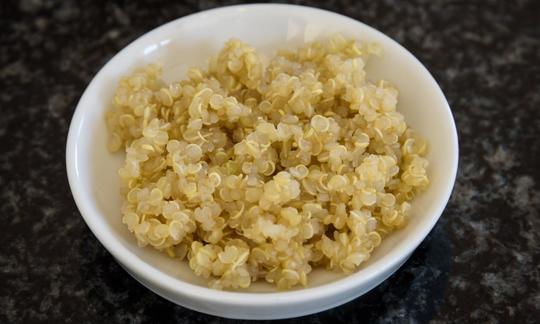

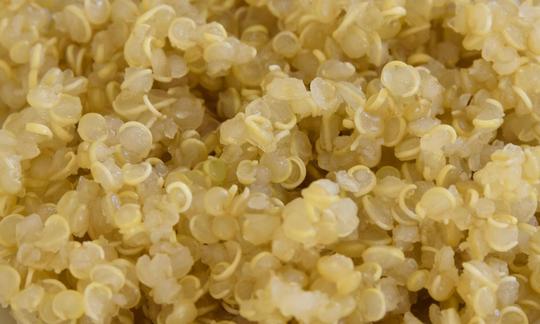

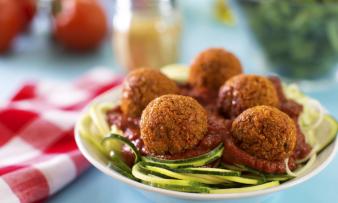
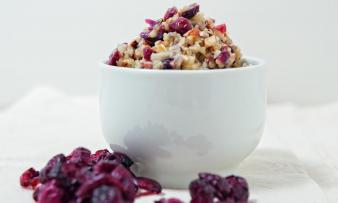
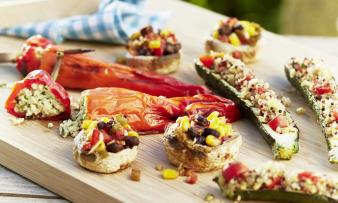

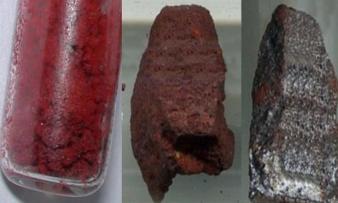



Comments